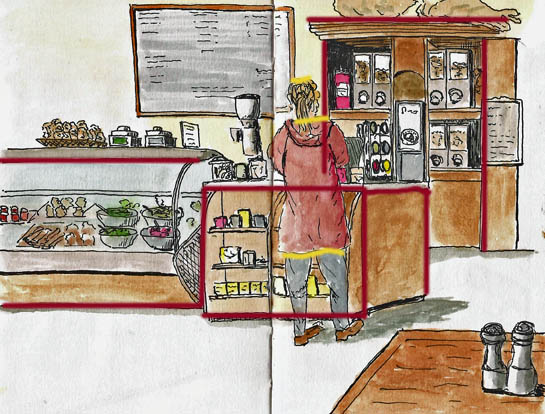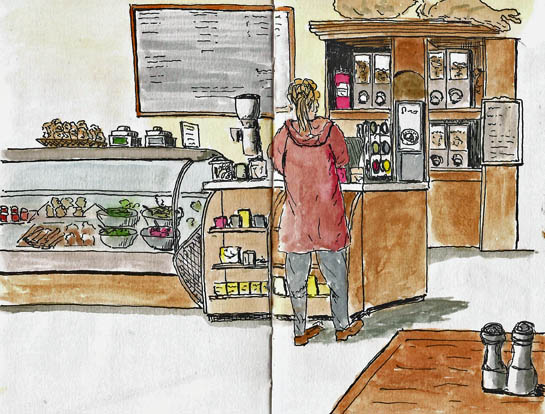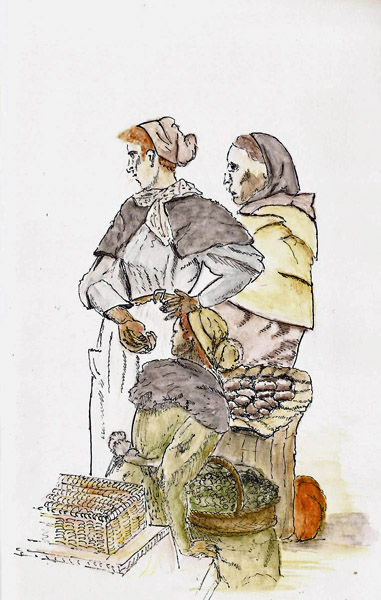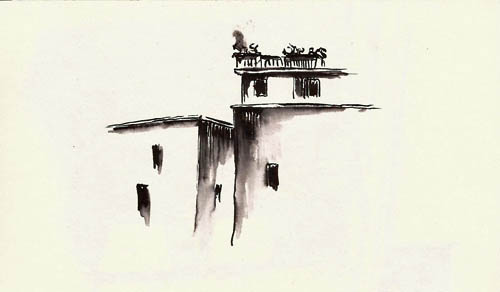On my way back from a discussion with a bank manager I stopped into a place for a cup of tea and the possibility of sketching an interior scene. It wasn’t the Taj Mahal but what the heck, it was great practice. Here’s the result, done in a Stillman & Birn (4×6) Alpha sketchbook. I used a TWSBI Mini as my pointy device.
While the counters, coffee and tea didn’t move, the people did as one after the other, a person came to the counter, paid for something, and left. I’ve been asked several times about how I set up a sketch like this and I thought it might be time to oblige.
It’s fashionable in internet-land to proudly state that one doesn’t use pencil. Ink is the only way to go. Well, I’m an ink guy and most of my sketching is done in ink. But I’ve also learned that laying down a few bones beforehand allows me to concentrate on the drawing of each section of a sketch and prevents my ideas from running off the page.
 So, I start with a pencil, a 3H pencil to be exact. I draw lines to represent the major vertical and horizontal components. I’ve indicated the pencil work for this sketch in red. Once done, I can look at the paper space and compare it to the scene, ensuring that things are going in the right direction. Note how few lines are actually required. This is not drawing; it’s organization.
So, I start with a pencil, a 3H pencil to be exact. I draw lines to represent the major vertical and horizontal components. I’ve indicated the pencil work for this sketch in red. Once done, I can look at the paper space and compare it to the scene, ensuring that things are going in the right direction. Note how few lines are actually required. This is not drawing; it’s organization.
In this case I also wanted to place a person and I could use counter height and the verticals to locate her. I’ve indicated three small pencil lines in yellow that define the top of her head, her shoulders as well as the bottom of ‘her’ coat. The reality is that the coat was drawn mostly from the first customer but also the second, who contributed the legs/shoes. A third provided the head, but as I had these little lines in place, it was easy to cobble together a person for my scene. Given how light the pencil lines are, I rarely see a need to erase them when I finish so no eraser was harmed in the creation of this sketch.
Could I do this with dots from a pen? Sure. When I did Brenda Swenson’s 75-Day Challenge (limits you to ink only) that’s exactly what I did. But it’s far easier to see the scene structure with some lines than with a few dots and a .5mm pencil isn’t that heavy so I carry one for this purpose. Besides, if layout underpinnings was good enough for the master artists of the 18th and 19th Century, why shouldn’t it be good enough for me (grin)?
 The next day I was meeting a friend for tea at one of my favorite haunts and this guy, all scrunched down in his chair caught my eye. I sketched him and then just kept going, ending up with this scene.
The next day I was meeting a friend for tea at one of my favorite haunts and this guy, all scrunched down in his chair caught my eye. I sketched him and then just kept going, ending up with this scene.











